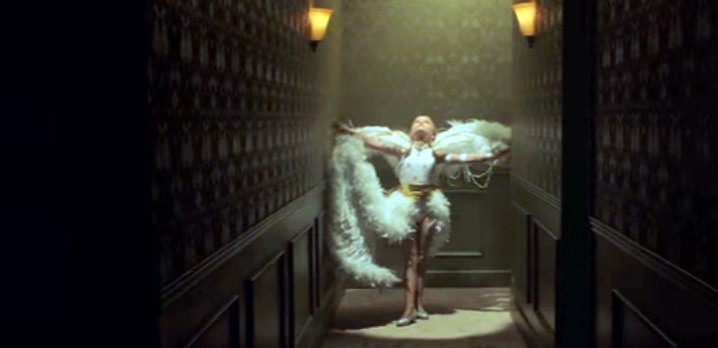
This article contains spoilers.
Tomcat centers around one sharp moment of horror. A single lightning bolt out of nowhere that leaves you breathless. Tomcat is a quiet and intimate film with a wound at the center. This not only describes the film but it also describes Stefan, one of the two men in the lead couple.
Stefan and Andreas are living a sweet and joyful life together. The camera stays close to them and the screen is full of their skin. We witness a soft and idyllic relationship shared by two men deeply in love. The look and feel of the film lulls you into a calm that only makes the horrific disruption more painful.
The movie was made by Klaus Händl in 2016. It was filmed in Austria and is in German. The German word for tomcat, “kater,” also means hangover. The title is a pun that foreshadows unwanted aftereffects or consequences.
The terrifying event comes completely without warning when Stefan, while gently stroking the couple’s cat Moses, suddenly breaks the cat’s neck. We assume the shattering event must be the result of some kind of hidden rage inside Stefan, but it’s all too shocking to even digest. The resulting fallout disrupts the trust between Stefan and Andreas. More to the point, it disrupts Stefan’s trust in himself. Essentially the film is about Stefan’s inner conflict and the couple’s efforts to reconstruct the trust that has been destroyed.
These issues are psychological but the murder feels less like an emotional expression and more like an existential crisis. It is a sudden burst of something primal. An emphatic statement about power and freedom, where the instinctual pull toward survival and dominance becomes an overwhelming impulse to take control of one’s life.
Tomcat expresses its existentialism by treating Moses’ murder as nothing more than one event among many. It is not extensively unpacked or carefully interpreted. There is some small amount of soul searching but mostly it is left as an abject occurrence. What might be seen as indicative of Stefan’s inner nature, something that reveals something deep inside him, is left relatively unexplained, almost as if it wasn’t about Stefan at all but about all of us, about the human condition. Any of us could suddenly tear asunder our reality in a single horrifying gesture.
Tomcat is very different from The Killing of a Sacred Deer but there is something about the bluntness, the empty, obvious nature of our words and actions that seem to connect the two films. There is a recognition of our inner psychological life but there is also a recognition that what is internal is not concrete. It is our words and actions that appear in the world, sometimes without our bidding. Beginning with Schopenhauer in the 1840s and running all the way through to the 1960s with Sartre the existentialists discovered that man is not the master of his fate or destiny or even his own thoughts or actions. We are deeply, irreconcilably conflicted and the forces and impulses that fight inside us are largely out of our control.
Stefan immediately regrets his deed. There is no premeditation leading up to it, and it is followed immediately by regret. A lightning fast impulse that took hold of him as if it originated outside of him. Or so deep within him he had no idea it was there.
The aftershocks of the event reverberate much as they would if Stefan had cheated on Andreas, but no matter how drunk, spontaneous, and meaningless an illicit hook up might be there is far too much time involved for it to be the product of one isolated impulse. Stefan betrays himself and his lover before he realizes anything has happened. He cuts himself in two and in so doing cuts his relationship with Andreas in two. The luxurious camera shots of their lovemaking and intimacy are replaced by uncomfortable, distant shots that separate them.
After the murder, when the two men are trying to find a way forward Stefan falls out of a tree and loses an eye. This seems like an Oedipal reference, where Stefan/Oedipus punishes himself for his transgression. This would make the cat the mysterious sphinx who warns Stefan /Oedipus of impending doom. The Oedipal complex as described by Freud deals with completely unacceptable emotions and desires that must remain sublimated and outside of our awareness. Unfortunately for Stefan it seems that they manage to burst forth in one murderous impulse.

What is left is a reevaluation of their relationship with each other, and Stefan’s reevaluation of his relationship with himself. Had the two men been harboring secret anger toward each other? Had Stefan been repressing something that finally burst out? These questions are not answered. What we see is Stefan and Andreas’ attempt at repairing their trust and moving forward.
The final resolution involves a mental, rational, reconciliation but Andreas is unwilling to have sex with Stefan. Andeas’ deeper feelings, his libidinal urges refuse to reignite. Deep inside he can not control something so basic as sexual attraction. His body will not follow his mind, similar to Stephan’s experience with the cat.
Tomcat presents an isolated action that both the characters and audience must reckon with. It’s an insistent concrete moment that sits unmoving like a roadblock. It tells us that the reality we live in is a surface overlaying a powerful set of forces we know little about. Tomcat reveals the existence of this world but does not describe or explain it, leaving us to do the work.

If you enjoyed this article you might also enjoy this related article - https://filmofileshideout.com/archives/the-black-cat-and-the-queer-string-of-films-it-inspired/




[…] If you enjoyed this article click here for morewww.filmofileshideout.com/archives/the-role-of-conflict-in-tomcat […]